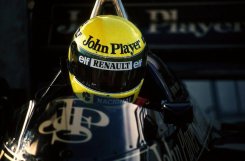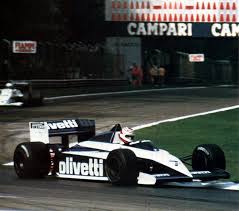1. Niki Lauda  / John Watson
/ John Watson 
2. Alain Prost 
The McLaren team never dominated the 1985 season the way they had in 1984, mainly due to a combination of Niki Lauda’s dreadful luck during the season, in which he only scored points three times, and the improved standard of competition from the likes of Lotus, Ferrari and Williams. Nonetheless, they were never seriously in danger of losing the titles after Ferrari’s season imploded from mid-season and Alain Prost took a leaf out of Lauda’s 1984 book by driving a canny season, winning when he could but always willing to back off and just take the most points realistically available. With Lauda moving on for `86, his replacement Keke Rosberg would be interesting to watch in the car: would his scruff-of-the-neck style be suitable for the meticulously prepared car?

Tyrrell-Ford / Renault
3. Martin Brundle 
4. Stefan Bellof  / Ivan Capelli
/ Ivan Capelli  / Phillippe Streiff
/ Phillippe Streiff 
Uncle Ken’s boys were at least allowed to keep all their points this year, but it was another disappointing season for them. Despite FOCA smoothing the way for a turbo engine deal with Renault, they weren’t ready until mid-season and in the event didn’t really help much. Martin Brundle was again a strong contender and must have been scratching his head at how he managed not to score any points this season. The loss of Stefan Bellof hit the team hard psychologically, but in fact Capelli and Streiff turned out to be good replacements and the Italian scored the team’s first ever turbo points with a solid if fortuitous run to fourth in Australia. A consolidation year as much as anything else, the team might look to push on in 1986.
5. Nigel Mansell 
6. Keke Rosberg 
The Williams team, having gone through something of a lean patch since the high points of 1980-81, were back with a vengeance this year. The chassis problems that had dogged 1984 were gone and, although the team didn’t quite get into the full swing until the second half of the year, bringing Nigel Mansell his long-awaited first win, to confirm his credentials as a talented driver, which in turn brought out the competitor in Rosberg. The Finn’s departure for McLaren next year could upset the team who have become used to having him around, but his replacement by Nelson Piquet has the potential to bring even more success.
7. Nelson Piquet 
8. François Hesnault  / Marc Surer
/ Marc Surer 
Brabham’s “good year, bad year” cycle was broken in 1985, though not in the way boss Bernie Ecclestone would have wanted. The BMW engine still had reliability issues – though it had improved since 1984 – and the chassis also had handling problems which proved too much for poor Hesnault, way out of his depth in the early races. Another major factor was the tyres – Pirelli rubber just didn’t work as well as the Goodyears, though Brabham arguably had the best of them, since they had worked closely with the Italian firm over the off-season to develop the tyres and clocked up thousands of testing miles in Rio and Kyalami, which gave the tyres an advantage in hot weather. Marc Surer proved an able backup and only some bad luck in the last few races with reliability prevented him from standing on the podium. However, this would be the year that Nelson Piquet finally lost patience with the stuttering team and departed – who could they find to fill the Brazilian’s big shoes? Niki Lauda was spoken of, but even if he could be tempted, it was only a short-term solution.
9. Manfred Winkelhock 
10. Phillippe Alliot 
A promising off-season seemed to indicate that the RAM 03 chassis was a decent package and Manfred Winkelhock got some good times in it, but it all seemed to evaporate once the season got underway; Hart spent much of the early season with their own problems, which affected engine development, and the death of Manfred Winkelhock deprived the team of probably their best asset. There was a real sense from that point onwards that Ralph and Macdonald’s hearts just weren’t in it any more, and their decision to first run Alliot as a sole driver and then skip the flyaway races entirely seemed to confirm it. They say they are regrouping ahead of 1986, but rumours persist that we may have seen the last of the team who have been so consistently unsuccessful since arriving as March in 1981.
11. Elio de Angelis 
12. Ayrton Senna 
The iconic British team’s best season in some time; Ayrton Senna looked an instant star and indeed it was remarkable how quickly the young Brazilian looked at home at the front, winning only his second race for the team. It was only the team’s reliability letting him down that prevented him from putting together a title challenge, such was his speed when combined with the excellent car. Elio de Angelis, meanwhile, in his sixth season with the team, looked for a while as if the arrival of Senna would challenge him and improve his own performances, but as soon as it became clear he was being outclassed by his younger team-mate, he seemed to lose interest and was quite happy to circulate in the lower points. Questions were asked about whether the Lotus team could really run two “top” drivers and support both, while de Angelis will hope for a fresh start at Brabham like the one Mansell had at Williams.
15. Patrick Tambay 
16. Derek Warwick 
And so Renault, the team who brought turbocharged engines to Formula One, ended their expensive nine-year experiment with more failure. It was Lotus, as engine customers, who gave Renault their only wins in 1984, while the factory team simply proved an embarrassment. It was clear as early as winter testing that the new car was a dud, and nothing the team could do helped matters. The updated RE60B was marginally faster, but nothing to write home about, and the team’s good performance at Zandvoort was probably due to running light on fuel, an insult to both drivers, who nonetheless gave their best all season. It wasn’t a huge surprise when Renault announced their departure from the sport before the Italian Grand Prix, and Patrick Tambay at least has seciured a drive for next year already with the Lola team.
17. Gerhard Berger 
18. Thierry Boutsen 
The Arrows team made good progress in 1985, with Boutsen a solid team leader and Berger a decent number two once he got more experience under his belt towards the end of the season. The car was a good one, the BMW engines’ improvement in reliability was most welcome and the cream-coloured cars often looked like rivals for the Brabhams later in the season. Thierry Boutsen’s second place in Imola may have been inherited after Prost’s disqualification, but it was still no mean feat and equalled the team’s best-ever placing with Riccardo Patrese in 1981. The team can hopefully look forward to better again in 1986.
19. Teo Fabi 
20. Piercarlo Ghinzani 
From points scorers with Warwick, to podiums with Senna, the team had something of a comedown in 1985, but you have to wonder what could have been if their early season hadn’t been scuppered by the tyre situation. In the event, once they had mended bridges with Pirelli, they were often one of the Italian company’s better runners although points proved another matter, and expanding to a second car might have been a mistake. At least the team showed their potential with Teo Fabi’s pole position, and with backing from the Benetton firm set to increase after Alfa Romeo’s withdrawal they can still be optimistic for next year.
21. Mauro Baldi 
Sadly, it looks like the three races the impoverished Spirit team contested at the start of the season were their last in Formula One, despite boss Wickham’s best intentions of returning in 1986. The team has always had an uphill battle to continue racing in the face of their lack of backing, and look set to join the long list of lower-formula teams for whom F1 was a step too far.
22. Riccardo Patrese 
23. Eddie Cheever 
If Renault were a high-profile embarrassment to their parent company, Alfa Romeo disappeared with hardly a whisper: about the only times they were ever on camera was when they blew up or crashed spectacularly, with the exception of a couple of good Cheever drives on street tracks before the inevitable failure. The illustrious marque failed to score a single point in 1985, putting them in the same category as Minardi, Osella and RAM, and when the announcement of their withdrawal was made after an Australian Grand Prix that saw both cars park up together at the very start, no-one was really surprised. The company will continue supplying engines to Osella for the time being, however. One has to hope that the two talented drivers – and particularly supreme racer Cheever – will find a decent new seat for ’86.
24. Piercarlo Ghinzani  / Huub Rothengatter
/ Huub Rothengatter 
Poor Osella looked like they had finally made some progress in 1984, establishing themselves as solid midfield runners, but a combination of the poor Alfa Romeo engine and a lack of funds saw them dropping back towards the rear. Piercarlo Ghinzani began the season driving for free, stepping aside when Huub Rothengatter arrived with some more backing. The Dutchman seemed to enjoy himself and did OK when the car allowed him, with a 7th place finish in Australia the highlight for both Huub and Osella, and a reward for the perseverance of both.
25. Andrea de Cesaris  / Phillippe Streiff
/ Phillippe Streiff 
26. Jacques Laffite 
The return of Jolly Jacques to the team with which he had previously been synonymous saw a revival of both party’s fortunes. The JS25 was a decent car for a change, thanks to the arrival of designer Michel Tetu, and with him came team manager Gerard Larrousse who sorted the team’s internal politics out. Laffite and de Cesaris put in some good drives, and the Italian’s sacking was unexpected. Nonetheless, Streiff proved an able replacement and was rewarded with a podium place in Australia (despite his best efforts to take both cars out). WIth continuity of engine, tyre and key personnel (Laffite, Tetu, Larrousse) in 1986, the team will hope their renaissance can continue.
27. Michele Alboreto 
28. René Arnoux  / Stefan Johansson
/ Stefan Johansson 
The Scuderia looked good early on, and despite the baffling sacking of Arnoux, Stefan Johansson stepped in with aplomb and performed well. For the first half of the season, Ferrari and Alboreto looked like the best competition for Prost and McLaren, but as they had in previous years, the team simply imploded in the second half of the season and after the lucky win in Germany they rarely looked like challenging and even when they did get into a good position the car inevitably broke. Alboreto’s frustration came out in his stubborn drive back to the pits with a burning car at Brands Hatch, but in reality even if the cars had been reliable it might not have helped much – the Ferrari V6 turbo lacked the grunt of the BMWs, TAGs and Hondas, and the car was difficult to set up on rough tracks. The team kept tinkering, but nothing worked for long. Another frustrating Ferrari year; the team would hope for better in 1986.
29. Pierluigi Martini 
The little Italian team had something of a rough start in Formula One – the inexperience of driver Pierluigi Martini and the apparently amateurish pit-crew made the team a bit of a laughing stock early on. They improved, however, as the season went on, but nonetheless the team was restricted to scrapping at the back with the Osella and waiting for the inevitable breakdown or Martini spin. Carlo Chiti’s Motori Moderni engine was decent enough, but lacked power and development. They’ll be back next year and hope for more development in the meantime.
30. Jonathan Palmer  / Christian Danner
/ Christian Danner 
If Minardi looked bumbling, amateurish and stereotypically Italian, Zakspeed looked organised, efficient and stereotypically German. Unlike Pierluigi Martini, Jonathan Palmer has a decent amount of race and testing experience, and helped the team immensely with their development until he was ruled out by injury. Christan Danner didn’t have quite the same impact, but nonetheless the team made solid progress and probably benefitted from missing the flyaway races to enable them to concentrate on getting the package right ahead of a full season in 1986.
33. Alan Jones 
It’s difficult to assess Carl Haas’s big-money F1 venture on the basis of the four entries this year, the whole thing more of an extended testing exercise than any kind of campaign. Questions were raised about Alan Jones’ fitness after his long layoff, but he seemed to be enjoying himself at least and the arrival at the team of development specialist Patrick Tambay bodes well for a good off-season of development and the team generally seemed to know what they were about, so they might well be dark horses in 1986 – if the promised exclusive Ford Turbo engine is up to snuff, of course.
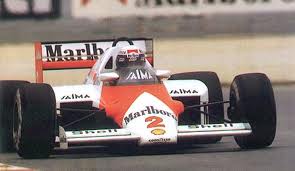





































 4. Ivan Capelli
4. Ivan Capelli 
 the rest, with Mansell also easing away from de Angelis to keep up the pursuit. On lap 7, Rosberg tried to get inside Senna at the Graham Hill corner, and succeeded in getting his nose ahead, but span on the exit and was rear-ended by Piquet while recovering. The Brabham’s nose was smashed and Piquet was out, but Rosberg managed to limp round to the pits for a new rear wing and new tyres (having punctured his during his excursion onto the grass).
the rest, with Mansell also easing away from de Angelis to keep up the pursuit. On lap 7, Rosberg tried to get inside Senna at the Graham Hill corner, and succeeded in getting his nose ahead, but span on the exit and was rear-ended by Piquet while recovering. The Brabham’s nose was smashed and Piquet was out, but Rosberg managed to limp round to the pits for a new rear wing and new tyres (having punctured his during his excursion onto the grass).



 Spa-Francorchamps
Spa-Francorchamps
 30. Christian Danner
30. Christian Danner 




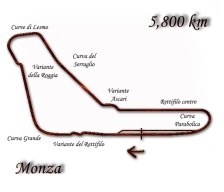
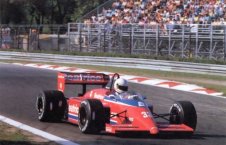

 25. Phillippe Streiff
25. Phillippe Streiff 